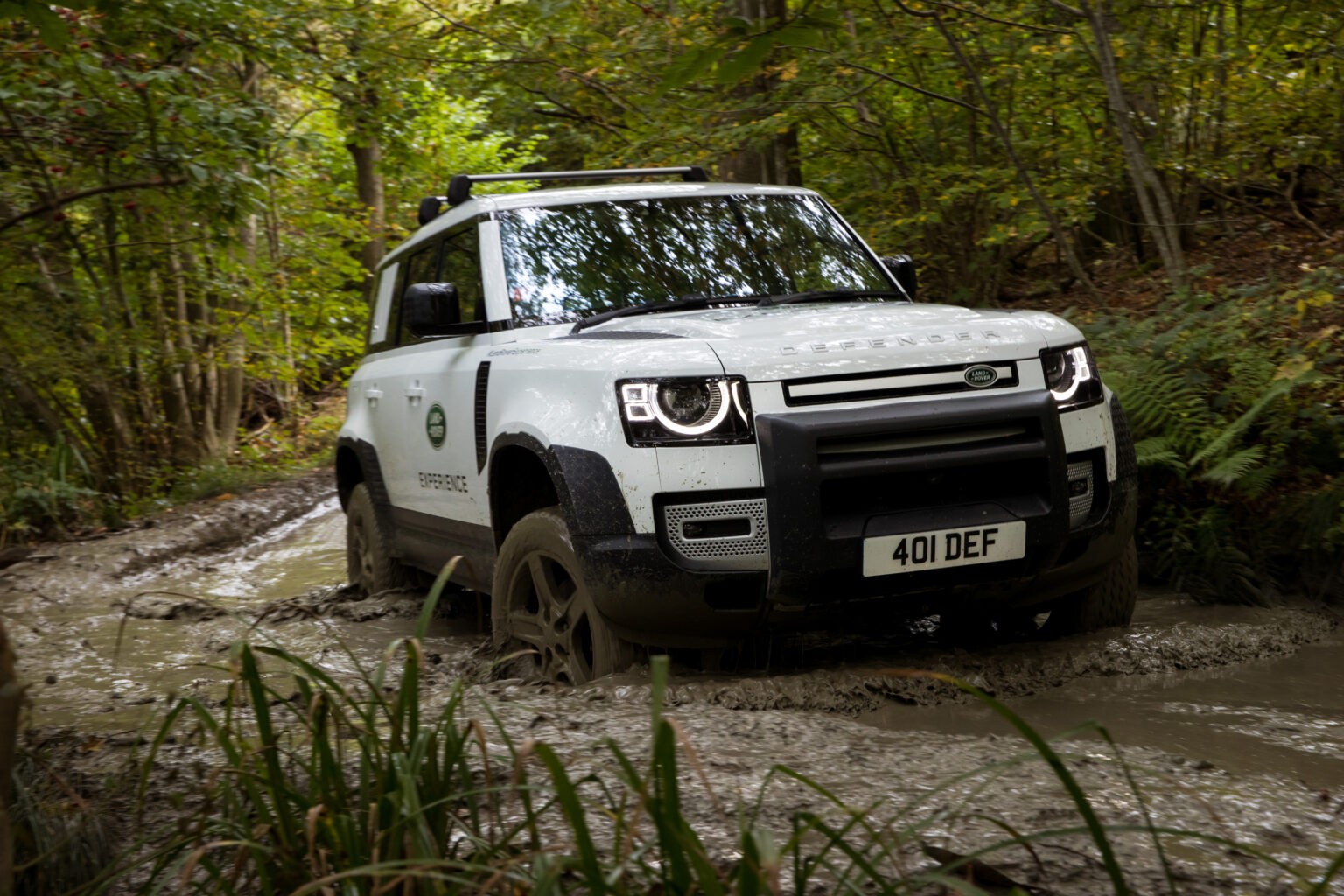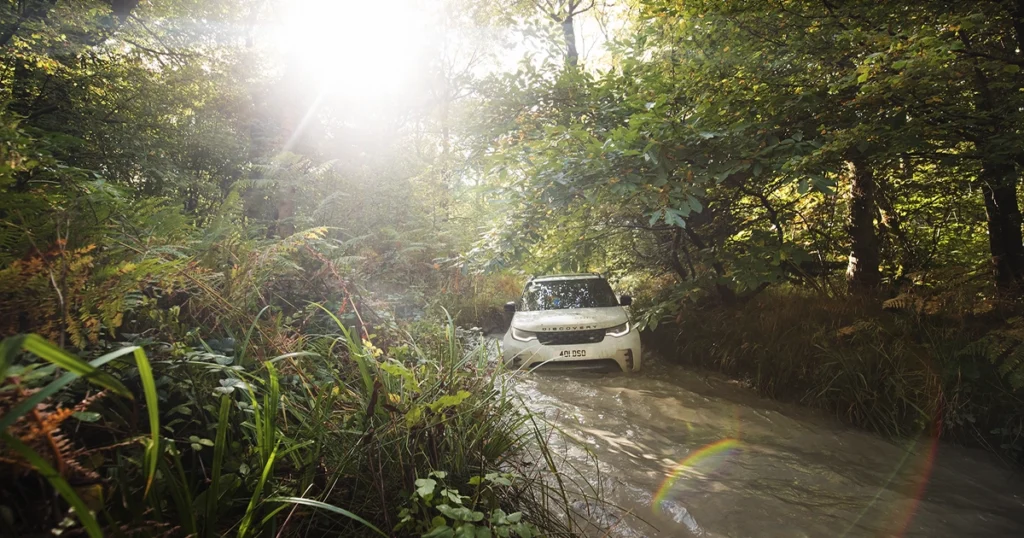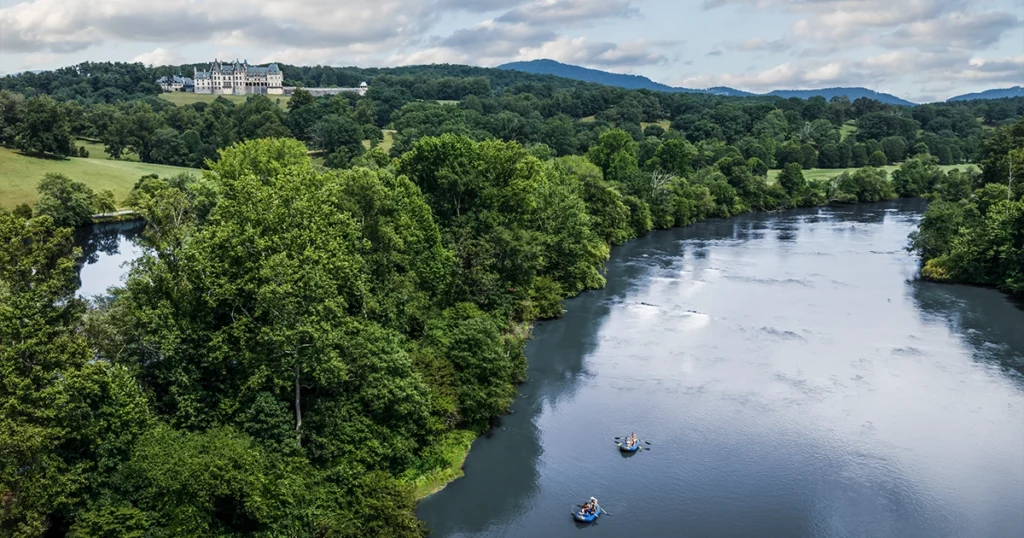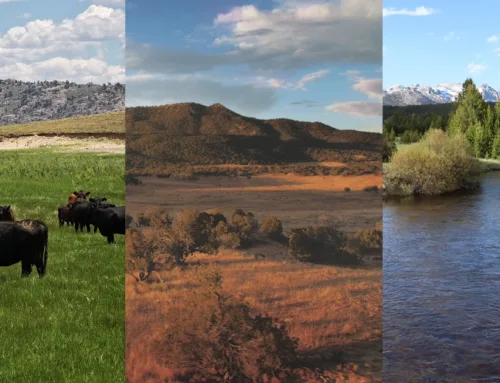Off-Road at the Biltmore Estate
Off-Road at the Biltmore Estate
By Drew Beard

Biltmore-opener-1536×1024
BILTMORE COURSE. There's no better way to explore the home of the nation’s largest private residence than behind the wheel of a Land Rover Defender 110.
“Take your pictures now because it [the car] will be filthy by the time we are finished here today.” Those are the very first words of advice I received from Sean Jones, a Land Rover senior instructor and my personal guide for the day at the Land Rover Experience Driving Center at the Biltmore Estate in Asheville, North Carolina.
We are at the top of the school’s East Course with the new Defender 110, about to begin an off-road exploration of this historic sporting property.
Biltmore is undoubtedly the most well-known estate in the nation. Much of its renown stems from the manor itself, Biltmore House, a palatial French Renaissance chateau commissioned by George Vanderbilt (1862–1914) and completed in 1895. At 175,000 square feet, Biltmore House ranks as the largest private residence in America.
The original grounds spanned 125,000 acres. “All the way out to Mount Pisgah,” Sean tells me as we navigate well-worn ruts on the first leg of the course. As much as I’d like to follow his train of thought, I’m doing my best to focus on the roots and the rocks ahead of me, not the stunning vistas or the downward-facing 3D cameras showing our wheel location on the dash display in high definition.
Most of the original estate had been hardscrabble farming tracts. With the assistance and counsel of Richard Morris Hunt, the architect of Biltmore House, and Frederick Law Olmsted, the gifted landscape architect who designed New York’s Central Park, Vanderbilt transformed the degraded dirt into a thriving estate.
“At one point, Biltmore had one of the largest and most successful dairies in the Southeast, with 1,800 dairy cows,” according to Kimber Jones, Biltmore’s agriculture and natural resources coordinator. The farming operations continued even after the estate dramatically downsized in 1914 with the sale of 87,000 acres to the United States Forest Service. That land would later become Pisgah National Forest, one of the first national forests east of the Mississippi.
While farming has always been a focus of the estate, the primary reason Vanderbilt chose to build his home in Asheville was the beauty of the Blue Ridge Mountains and the abundant recreation they provided. “We mimic those same uses today,” says Kimber.
In the late 19th century, outdoor activities at Biltmore ranged from horseback riding, hunting, and fishing to more leisurely ventures such as croquet and strolls through the lavish gardens with family and friends.
“While keeping that original vision alive, we also offer some more modern activities, such as our sporting clays course and, of course, the Land Rover Experience,” says Kimber.
In 1930, George and Edith’s only child, Cornelia, and her husband, John Cecil, made a singularly astute financial decision: They opened the great house and its expansive grounds to the paying public. Doing so not only further enhanced Biltmore’s popularity and renown, but it also ensured its financial viability for future generations of the family.
Land Rover established its school at Biltmore in 2004. While there are two other Land Rover schools in the States — one in California and another in Vermont — the Biltmore is the lead school in the country. “This place is like a North American Eastnor,” Sean tells me with pride on our drive.
That’s no small comparison. The Eastnor Castle property in Herefordshire is the premier proving ground for Land Rover. The challenging English terrain, spread across 5,000 acres, has been used to test and refine the iconic 4×4 since the early 1960s.
While Biltmore Estate has decreased in acreage over the decades, it remains larger than Eastnor. “We’re down to 8,000 acres,” Sean tells me as we crawl through a long, deep pool of muddy water near a riverbank with ease, relying on the Defender’s impressive Wade Sensing technology and an air suspension good for more than 11 inches of clearance. Dense forests blanket 5,000 of the remaining acres.
“The French Broad River bisects the property, with 4,000 acres on each side,” Sean explains as we approach the river. The portion of the river that divides the estate is ideal for kayaking and rafting, and guests can fly-fish in the property’s lagoon and lake. Fortunately for those of us who need to brush up on our casting, an Orvis-endorsed fly-fishing school is located on the estate.
Off the East Course and back on dryer, flatter roads, I’m impressed by how quickly the Defender reverts to a plush cruiser, even on gravel. “The air ride is quiet and comfortable. Once you get into these, it’s hard to get away from them,” Sean tells me. I’m not inclined to disagree.
We’re sharing a short piece of road between the two Land Rover courses with groups of trail walkers, bicyclists, and equestrians. In addition to more than 20 miles of walking paths, the estate boasts an impressive 80 miles of equestrian trails and is nationally recognized for its annual endurance races.
Everyone on the trail is definitely distracted by our new Defender’s rugged good looks. Its angular design is unmistakable and just as appealing as the original was 40 years ago. Or perhaps they’ve just never seen so much mud on such a nice car.
Sean, I learn during our drive, personally owns eight Land Rovers dating back to 1967. Prior to arriving at Biltmore, he owned a shop that specialized in Land Rover maintenance and restoration. The man is the ultimate devotee and an expert on the vehicle’s off-road abilities and its timeless aesthetic. How do enthusiasts like him feel about the recently relaunched Defender?
“My passion is the old Series trucks, but I admire the new technology. Even back in the day, if you look, Land Rover was just always a little ahead of the curve. They were the first 4×4 to have air suspension, as well as the first to have antilock brakes. They’ve always been pretty innovative,” he says.
That seems an understatement as I enter a steep downhill portion of the West Course in the Defender’s Hill Descent mode, an impressive bit of technology that applies different brake pressure to each wheel depending on the traction required. This ensures a steady and practically autonomous crawl down the muddy slope.
The west side of the property houses the estate’s farming operations. There are 700 head of registered Black Angus, around 150 White Dorper sheep, 160 Berkshire hogs, a few hundred laying hens, and 100 honeybee hives. Approximately 450 acres are planted in row crops. Biltmore is clearly no hobby farm.
“Most visitors won’t get to see this part of the property unless they do the Land Rover course,” Sean tells me.
As we approach a new stretch of obstacles, another Land Rover Experience instructor coming from the opposite direction stops to tell Sean about the terrain ahead. “It’s getting a little slippery back there,” he tells us through the window. “That’s why we’re here,” Sean responds matter-of-factly. “This car will be fine,” the other instructor offers. “Good driving conditions today. At least for us.”
As we come off the West Course, Sean gestures into the tree line at a collection of stands. “That’s one of our shooting courses.” Vanderbilt wasn’t known as an avid hunter, but he did keep a hunting camp at the base of Mount Pisgah. No doubt he hosted his share of shoots. Hunting isn’t allowed on the property today, but guests can enjoy a whiff of gunpowder at Biltmore’s Sporting Clays School or the members-only Sporting Clays Club, which is open to the public.
The property offers two different shooting ranges, one exclusively for club members. There are also two six-station sporting clays courses — the Vineyard Course and the more challenging Woodlands Course — as well as traditional trap and skeet ranges.
Guests are welcome to bring their own firearms and ammunition. Both are readily available on the premises.
As the afternoon winds down, we make our way back to the garage. Biltmore’s Land Rover Experience offers a choice of three current models or a vintage Defender 90. Naturally, I ask Sean which Land Rover model is his favorite. “If I’m honest, I like this Defender 110. The approach and departure angles are great, and it gets the job done,” he replies.
Once again, the maestro’s response leaves little room for dissent. Despite the fact that we never came close to the speed limit anywhere on the property, my drive has been exhilarating. Having co-piloted countless Land Rover drives over the years, Sean wasn’t surprised by my enthusiasm.
“A NASCAR driver who recently visited said it was the most fun he’d ever had driving three miles an hour,” he tells me with a laugh as we park for the day.
As I discovered, Biltmore Estate is so much more than just a palatial home. George Vanderbilt’s vision of a sanctuary in the Blue Ridge to relax and enjoy nature still thrives to this day and tallies more than 1 million visitors per year. While you can tour much of this stunning property on foot or in a boat or astride a saddle, I highly recommend you explore the trails less traveled in a Land Rover.
And I think you probably know which one I’d pick.








